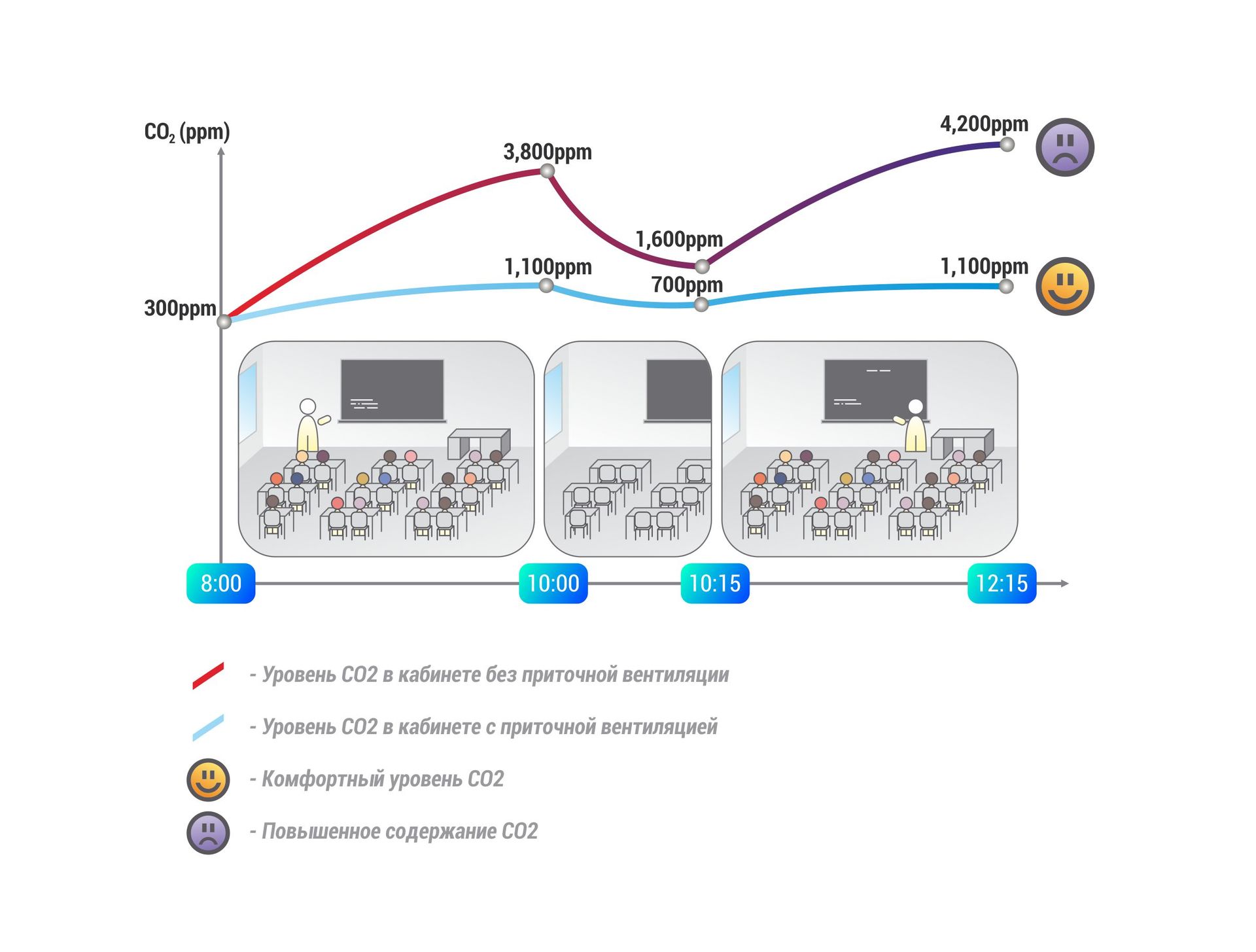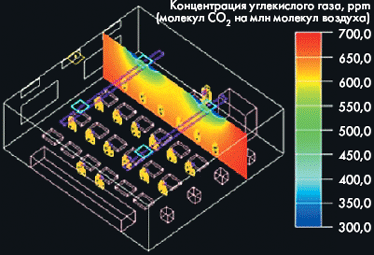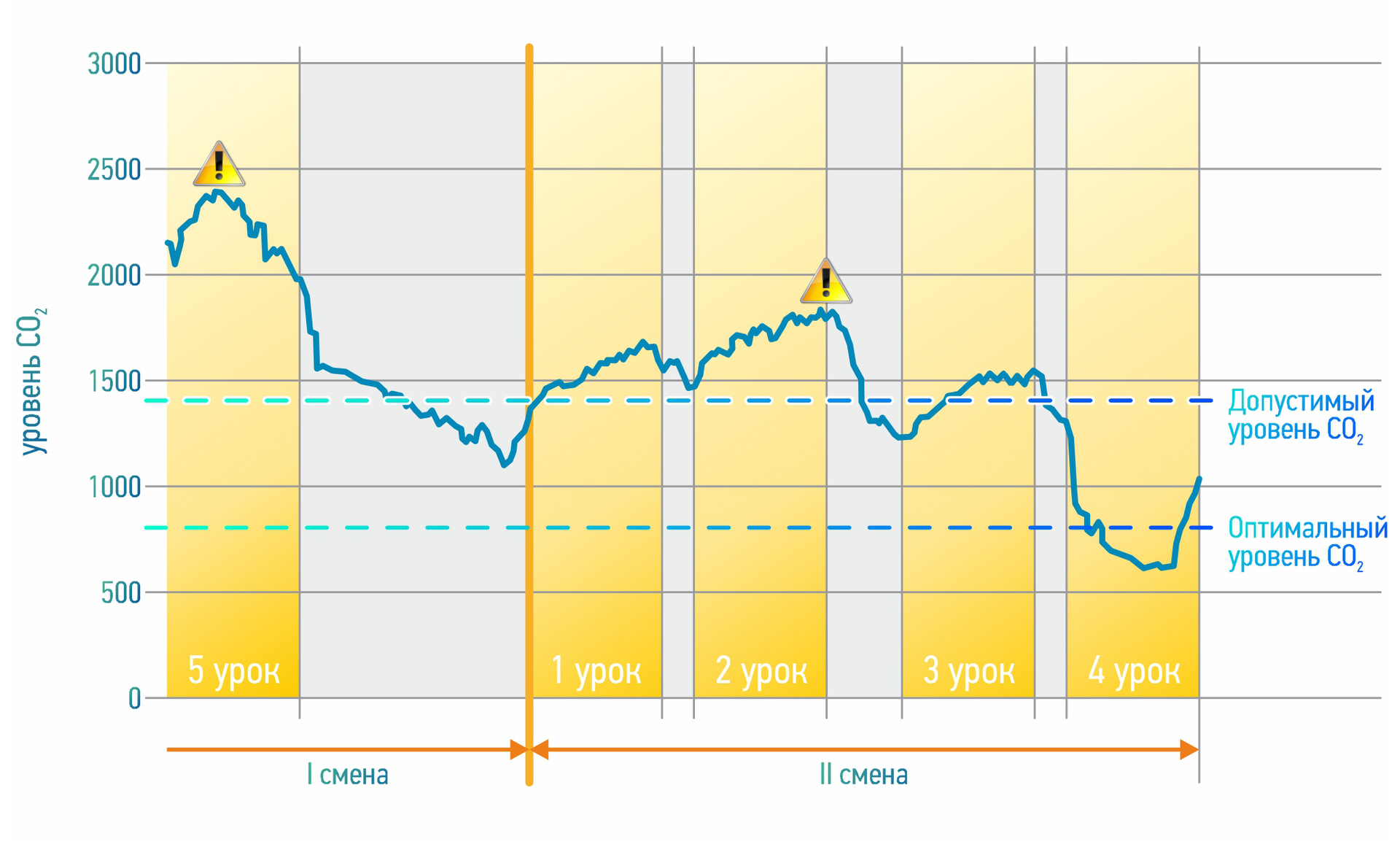The hunt for the stifling air, part 2. How much CO2 is in school?
Last time you read about carbon dioxide in the Tion Smart Microclimate company : why it is an important indicator of air quality and how much it is in Moscow. There was a small spoiler about our school mini-study in that article. As promised, we talk about it in more detail. But first, some general information about the problem of stuffy air in schools.

In European schools, the problem of the microclimate in general and the exceeded CO2 content in particular has long been known. There are conducted studies on this topic, with CO2 measurements and statistics, reports and manuals on the organization of school ventilation are published.
For example, the picture is from such a guide - “Effective ventilation for schools” (CETIAT, France, 2001). It shows graphs of CO2 level changes in the classroom during lessons (judging by the time scale, one lesson lasts 2 hours). For the construction of graphs used statistical data on several dimensions. Two situations are considered: an office without ventilation in general (with airing through a window during the break) and an office with properly functioning ventilation.

Recall, just in case, that the concentration of carbon dioxide is measured with parts per million (ppm). The optimal level is considered up to 800 ppm, acceptable - up to 1400 ppm. Read more about the effects of CO2 in our previous article.
')
According to the dark graphics, you can see: CO2 at school is not a topic of the first freshness, not only in the figurative but also in the literal sense. By the end of the second lesson in the office without ventilation, the CO2 level exceeded the permissible value by more than 3 times.
Of course, this is not the only evidence that in foreign schools there is trouble with stuffiness. Many modern educational institutions are located in old buildings, where ventilation is in a deplorable state. In April 2015, experts of the European Bureau of the World Health Organization sounded the alarm : European children in schools suffer from stuffiness, unpleasant odors and dampness in school premises. It is January 2016, and the situation is unlikely to have changed much.
Since 2011, in Europe and Central Asia, the research program “School environment and respiratory diseases in children” (“School Environment and Respiratory Health of Children”, or simply SEARCH) has been implemented. The program even created a special lesson plan , the purpose of which is to show the importance of fresh air and ventilation to teachers and children.
Unfortunately, Russia is not one of the member countries of SEARCH. This does not mean that there is no stifling air problem in Russian schools - it exists. This is regularly reported in the media ( example ). Yes, and domestic experts recognize the existence of the problem, as well as the fact that it almost does not pay attention.
We, as experts in the field of ventilation and microclimate, have decided to fix this. And they began with a small one-time measurement of CO2 in order to get at least a superficial idea of the level of CO2 in the Russian school.
For the measurement of CO2 in Moscow, we used the compact portable sensor Testo 480. For a long-term measurement of CO2 in a school class, a stationary sensor is more suitable. We used the Green Eye . Pre-sensor checked and calibrated.
An important condition for measuring CO2 in the school office is that the sensor must be in the breathing zone. It is known that in school and office premises the concentration of CO2 is closer to the ceiling than on the floor. This is logical, because carbon dioxide sources (teacher and schoolchildren) are “in the lower atmosphere”.
Even if the school has a central supply and exhaust ventilation, it is usually of a mixing type. In mixing ventilation, the supply and exhaust openings are located near the ceiling close to each other. In this case, active air exchange passes between these holes under the ceiling. A bubble of carbon dioxide around the pupils remains intact. This is seen in the picture below:

Therefore, it is important to measure the CO2 level in the lower zone of the room, at a height of about 1.5 meters from the floor. It was there that we installed our sensor.
Measurement period: from the fifth lesson of the first shift to the fifth lesson of the second. We, in contrast to the data of the French CETIT, lessons do not last for 2 hours, but 45 minutes each. There was standard school ventilation in the classroom - natural exhaust vents under the ceiling, there was no organized influx, air enters the classroom through windows and slots in the walls from the street and through the door from the corridor.
Go through the schedule from start to finish.

First shift
Fifth lesson: the class was not aired for a long time, and at the very beginning of the session the CO2 level was above 2000 ppm. The windows were closed, and the concentration of carbon dioxide rose even more and reached 2500 ppm. After the lesson, the students left the office. The teacher opened the window - the CO2 level dropped sharply: on the graph we see a sharp jump down. In ten minutes of change, with the window open, the amount of carbon dioxide decreased from 2000 to 1500 ppm.
The sixth lesson was not, the class remained empty, so carbon dioxide became less and less. By the beginning of the second shift, its amount reached an acceptable level. Closer to the beginning of the first lesson, the schedule crawled upwards - the students appeared in the classroom again. Began the second shift.
Second shift
During the first lesson of the second shift, the CO2 level increased by almost 300 ppm. After the class, the students released the room, but for some reason did not open the window. Therefore, for the change of carbon dioxide was not much less, and its amount was still above the norm.
In the second lesson, the same picture is observed: the CO2 level increased by another 300 ppm. Considering that it was not possible to air the class at the last break, by the end of the second lesson the amount of carbon dioxide reached a critical 1800 ppm. After the lesson there was a long break. This time, the window was opened, and the CO2 level dropped to an acceptable 1200 ppm.
The third lesson began with relatively fresh air. And in general, throughout the entire session, the amount of CO2 remained within 1500 ppm, and after airing it again decreased to 1200 ppm.
The fourth lesson turned out to be successful: the windows remained open throughout the session. Thanks to the constant airing, the air in the classroom remained fresh for 40 minutes. For the first time during the school day, schoolchildren held a lesson in the most healthy conditions. The CO2 level dropped below 1000 ppm and almost reached the natural level of 500 ppm.
As you can see, open windows at recess give a short-term reduction in CO2, this is enough to maintain the maximum allowable 1400 ppm. However, to maintain a truly healthy microclimate, you need to keep the windows open throughout the lesson. Often this is impossible because of the noise under the windows, cold drafts, unpleasant odors, smoke and so on. Organized ventilation will help. With it, the windows can be kept closed, fresh air will enter the room through special air inlets.
The location of the inlets is important. As we said above, mixing ventilation does not always help to normalize the level of CO2 in the school office. For school, another type of ventilation is more suitable - displacing. By the way, it is widely used in American and European schools.
In the preemptive ventilation, exhaust vents are also located under the ceiling, and the air inlets are near the floor. In this case, the fresh inflow displaces the stuffy, "spent" air from the bottom up. And the distribution of CO2 looks like this:

In many schools, it is difficult or even impossible to do central supply and exhaust ventilation, which is also displacing. This requires the laying of new air ducts, the installation of pressure air distributors and major repairs. In this sense, compact supply devices are much easier to install.
Our goal is to show that a normal, healthy concentration of CO2 can be achieved in any class. And the “little blood” for the school, without designing the central supply and exhaust ventilation and overhaul. To do this, we plan to conduct repeated measurements of CO2, but already in the classes with installed breathers .
For accuracy, our next study will include a sample of experiments. The results will definitely tell in our blog. Follow the news!
See also:
The hunt for the stifling air, part 1. How much CO2 in Moscow?


Theme is not the first freshness
In European schools, the problem of the microclimate in general and the exceeded CO2 content in particular has long been known. There are conducted studies on this topic, with CO2 measurements and statistics, reports and manuals on the organization of school ventilation are published.
For example, the picture is from such a guide - “Effective ventilation for schools” (CETIAT, France, 2001). It shows graphs of CO2 level changes in the classroom during lessons (judging by the time scale, one lesson lasts 2 hours). For the construction of graphs used statistical data on several dimensions. Two situations are considered: an office without ventilation in general (with airing through a window during the break) and an office with properly functioning ventilation.

Recall, just in case, that the concentration of carbon dioxide is measured with parts per million (ppm). The optimal level is considered up to 800 ppm, acceptable - up to 1400 ppm. Read more about the effects of CO2 in our previous article.
')
According to the dark graphics, you can see: CO2 at school is not a topic of the first freshness, not only in the figurative but also in the literal sense. By the end of the second lesson in the office without ventilation, the CO2 level exceeded the permissible value by more than 3 times.
Of course, this is not the only evidence that in foreign schools there is trouble with stuffiness. Many modern educational institutions are located in old buildings, where ventilation is in a deplorable state. In April 2015, experts of the European Bureau of the World Health Organization sounded the alarm : European children in schools suffer from stuffiness, unpleasant odors and dampness in school premises. It is January 2016, and the situation is unlikely to have changed much.
Since 2011, in Europe and Central Asia, the research program “School environment and respiratory diseases in children” (“School Environment and Respiratory Health of Children”, or simply SEARCH) has been implemented. The program even created a special lesson plan , the purpose of which is to show the importance of fresh air and ventilation to teachers and children.
Unfortunately, Russia is not one of the member countries of SEARCH. This does not mean that there is no stifling air problem in Russian schools - it exists. This is regularly reported in the media ( example ). Yes, and domestic experts recognize the existence of the problem, as well as the fact that it almost does not pay attention.
“In the Russian classes it is difficult to breathe also because of the plastic windows that are installed during the repair of schools. A plastic-enclosed room turns into a sealed chamber, and carbon dioxide in such conditions can exceed the standards many times. However, in our country there is practically no data on this subject, and there is no work on this issue. ”
© Head of the Laboratory for Forecasting Environmental Quality and Public Health, Doctor of Medicine Boris Alexandrovich Revich.
We, as experts in the field of ventilation and microclimate, have decided to fix this. And they began with a small one-time measurement of CO2 in order to get at least a superficial idea of the level of CO2 in the Russian school.
How to measure
For the measurement of CO2 in Moscow, we used the compact portable sensor Testo 480. For a long-term measurement of CO2 in a school class, a stationary sensor is more suitable. We used the Green Eye . Pre-sensor checked and calibrated.
An important condition for measuring CO2 in the school office is that the sensor must be in the breathing zone. It is known that in school and office premises the concentration of CO2 is closer to the ceiling than on the floor. This is logical, because carbon dioxide sources (teacher and schoolchildren) are “in the lower atmosphere”.
Even if the school has a central supply and exhaust ventilation, it is usually of a mixing type. In mixing ventilation, the supply and exhaust openings are located near the ceiling close to each other. In this case, active air exchange passes between these holes under the ceiling. A bubble of carbon dioxide around the pupils remains intact. This is seen in the picture below:

Therefore, it is important to measure the CO2 level in the lower zone of the room, at a height of about 1.5 meters from the floor. It was there that we installed our sensor.
What got
Measurement period: from the fifth lesson of the first shift to the fifth lesson of the second. We, in contrast to the data of the French CETIT, lessons do not last for 2 hours, but 45 minutes each. There was standard school ventilation in the classroom - natural exhaust vents under the ceiling, there was no organized influx, air enters the classroom through windows and slots in the walls from the street and through the door from the corridor.
Go through the schedule from start to finish.

First shift
Fifth lesson: the class was not aired for a long time, and at the very beginning of the session the CO2 level was above 2000 ppm. The windows were closed, and the concentration of carbon dioxide rose even more and reached 2500 ppm. After the lesson, the students left the office. The teacher opened the window - the CO2 level dropped sharply: on the graph we see a sharp jump down. In ten minutes of change, with the window open, the amount of carbon dioxide decreased from 2000 to 1500 ppm.
The sixth lesson was not, the class remained empty, so carbon dioxide became less and less. By the beginning of the second shift, its amount reached an acceptable level. Closer to the beginning of the first lesson, the schedule crawled upwards - the students appeared in the classroom again. Began the second shift.
Second shift
During the first lesson of the second shift, the CO2 level increased by almost 300 ppm. After the class, the students released the room, but for some reason did not open the window. Therefore, for the change of carbon dioxide was not much less, and its amount was still above the norm.
In the second lesson, the same picture is observed: the CO2 level increased by another 300 ppm. Considering that it was not possible to air the class at the last break, by the end of the second lesson the amount of carbon dioxide reached a critical 1800 ppm. After the lesson there was a long break. This time, the window was opened, and the CO2 level dropped to an acceptable 1200 ppm.
The third lesson began with relatively fresh air. And in general, throughout the entire session, the amount of CO2 remained within 1500 ppm, and after airing it again decreased to 1200 ppm.
The fourth lesson turned out to be successful: the windows remained open throughout the session. Thanks to the constant airing, the air in the classroom remained fresh for 40 minutes. For the first time during the school day, schoolchildren held a lesson in the most healthy conditions. The CO2 level dropped below 1000 ppm and almost reached the natural level of 500 ppm.
What's next
As you can see, open windows at recess give a short-term reduction in CO2, this is enough to maintain the maximum allowable 1400 ppm. However, to maintain a truly healthy microclimate, you need to keep the windows open throughout the lesson. Often this is impossible because of the noise under the windows, cold drafts, unpleasant odors, smoke and so on. Organized ventilation will help. With it, the windows can be kept closed, fresh air will enter the room through special air inlets.
The location of the inlets is important. As we said above, mixing ventilation does not always help to normalize the level of CO2 in the school office. For school, another type of ventilation is more suitable - displacing. By the way, it is widely used in American and European schools.
In the preemptive ventilation, exhaust vents are also located under the ceiling, and the air inlets are near the floor. In this case, the fresh inflow displaces the stuffy, "spent" air from the bottom up. And the distribution of CO2 looks like this:

In many schools, it is difficult or even impossible to do central supply and exhaust ventilation, which is also displacing. This requires the laying of new air ducts, the installation of pressure air distributors and major repairs. In this sense, compact supply devices are much easier to install.
Our goal is to show that a normal, healthy concentration of CO2 can be achieved in any class. And the “little blood” for the school, without designing the central supply and exhaust ventilation and overhaul. To do this, we plan to conduct repeated measurements of CO2, but already in the classes with installed breathers .
For accuracy, our next study will include a sample of experiments. The results will definitely tell in our blog. Follow the news!
See also:
The hunt for the stifling air, part 1. How much CO2 in Moscow?

Source: https://habr.com/ru/post/367689/
All Articles